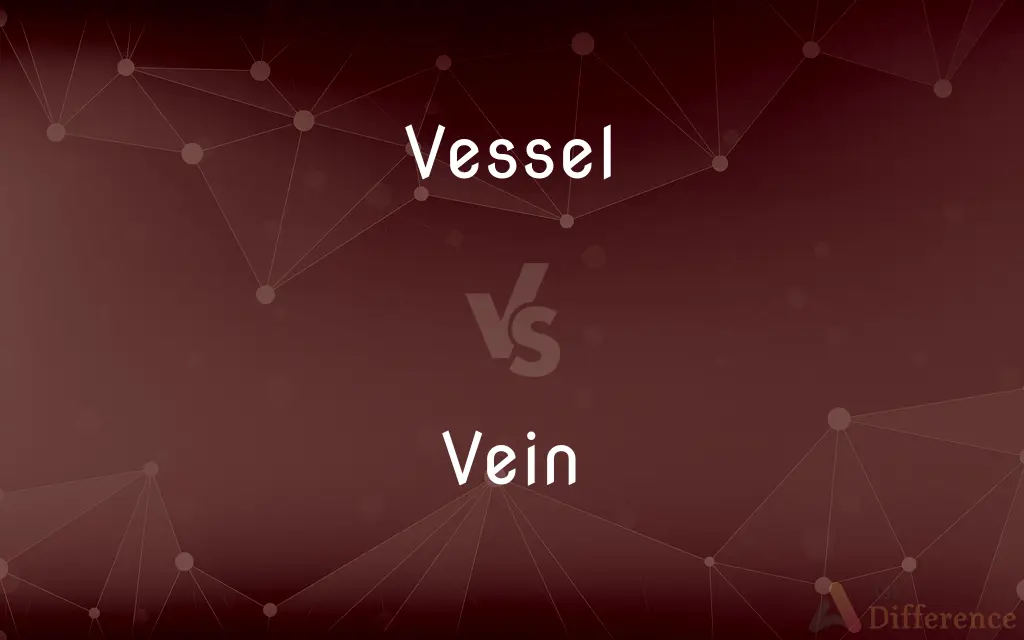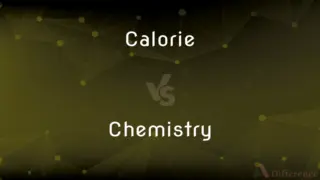Vessel vs. Vein — What's the Difference?
Edited by Tayyaba Rehman — By Urooj Arif — Updated on April 3, 2024
A vessel is a general term for any tubular structure carrying blood or lymph in the body, while a vein is a specific type of blood vessel that returns deoxygenated blood to the heart, except for pulmonary veins.

Difference Between Vessel and Vein
Table of Contents
ADVERTISEMENT
Key Differences
Vessels constitute the network of tubes within the body that transport fluids, such as blood and lymph. This category encompasses various types, including arteries, veins, and capillaries, each serving distinct roles in the circulatory and lymphatic systems. Arteries carry oxygenated blood away from the heart (except for pulmonary arteries), capillaries facilitate the exchange of gases, nutrients, and waste at the cellular level, and lymphatic vessels are involved in the immune response and the return of lymph to the bloodstream. On the other hand, veins are a subset of vessels specifically responsible for carrying deoxygenated blood back to the heart, with the exception of pulmonary veins that carry oxygenated blood from the lungs to the heart.
The structure of vessels varies according to their function. For example, arteries have thick, elastic walls to withstand high pressure from the heart's contractions, whereas veins have thinner walls and valves to prevent backflow of blood, as they operate under lower pressure. Capillaries, being the site for exchange, have very thin walls to allow substances to pass through easily. Veins, in their capacity to return blood to the heart, are equipped with a series of one-way valves that ensure blood flows in the correct direction, countering the force of gravity, especially in the legs.
While all vessels are essential components of the circulatory system, veins have unique adaptations for their role in blood return, including the presence of valves and the ability to expand to accommodate varying volumes of blood. This adaptability is crucial for maintaining steady blood flow back to the heart, especially during physical activity when blood flow increases.
Veins also play a significant role in the thermoregulatory processes of the body. By controlling the volume of blood flowing through superficial veins, the body can regulate heat loss. In contrast, the primary function of other vessels, like arteries, is to deliver blood rich in oxygen and nutrients to tissues, highlighting the complementary roles different vessels play in bodily functions.
Despite these differences, the health of all vessels is vital for overall well-being. Diseases can affect vessels in various ways, such as atherosclerosis impacting arteries or varicose veins affecting the veins, each with specific implications for blood flow and general health.
ADVERTISEMENT
Comparison Chart
Definition
Tubular structures carrying blood or lymph
Blood vessels returning deoxygenated blood to the heart
Types Included
Arteries, veins, capillaries, lymphatic vessels
Part of the blood vessel category
Wall Thickness
Varies (thick in arteries, thin in capillaries)
Generally thinner than arteries, with valves
Blood Direction
Depends on the type (away from or toward the heart)
Toward the heart
Function
Transport blood or lymph, facilitate exchange
Return deoxygenated blood to the heart
Pressure
Varies (high in arteries, low in veins)
Lower than in arteries
Valves
Present in veins and lymphatic vessels
Present to prevent backflow
Compare with Definitions
Vessel
Includes arteries, veins, and capillaries.
Blood vessels are crucial for circulating oxygen and nutrients.
Vein
A type of blood vessel that carries blood back to the heart.
The veins in your legs work against gravity to return blood to the heart.
Vessel
Varies in structure based on function.
The elasticity of arterial vessels helps accommodate blood pressure surges.
Vein
Operates under lower pressure compared to arteries.
Veins expand to accommodate increased blood flow during exercise.
Vessel
A conduit for transporting blood or lymph throughout the body.
The rupture of a blood vessel can lead to internal bleeding.
Vein
Contains valves to prevent backflow.
Varicose veins occur when valves in the veins fail to function properly.
Vessel
Essential for bodily functions and homeostasis.
Vascular health is vital for overall well-being.
Vein
Excludes pulmonary veins in the definition.
Pulmonary veins are the exception as they carry oxygenated blood to the heart.
Vessel
Found throughout the body in the circulatory and lymphatic systems.
Lymphatic vessels play a key role in immune defense.
Vein
Involved in thermoregulation by controlling blood flow.
Blood vessels in the skin, including veins, adjust to regulate body temperature.
Vessel
A ship or large boat.
Vein
Veins are blood vessels that carry blood towards the heart. Most veins carry deoxygenated blood from the tissues back to the heart; exceptions are the pulmonary and umbilical veins, both of which carry oxygenated blood to the heart.
Vessel
A hollow container, especially one used to hold liquid, such as a bowl or cask.
Vein
Any of the tubes forming part of the blood circulation system of the body, carrying in most cases oxygen-depleted blood towards the heart.
Vessel
A duct or canal holding or conveying blood or other fluid.
Vein
A fracture in rock containing a deposit of minerals or ore and typically having an extensive course underground
Gold-bearing quartz veins
Vessel
A hollow utensil, such as a cup, vase, or pitcher, used as a container, especially for liquids.
Vein
A distinctive quality, style, or tendency
He closes his article in a somewhat humorous vein
Vessel
(Nautical) A craft, especially one larger than a rowboat, designed to navigate on water.
Vein
(Anatomy) Any of the membranous tubes that form a branching system and carry blood to the heart from the cells, tissues, and organs of the body.
Vessel
An airship.
Vein
A blood vessel of any kind; a vein or artery
Felt the blood pounding in her veins.
Vessel
(Anatomy) A duct, canal, or other tube that contains or conveys a body fluid
A blood vessel.
Vein
Something that looks like a blood vessel, such as the hindgut of a shrimp.
Vessel
(Botany) One of the tubular water-conducting structures of xylem, consisting of a series of vessel elements attached end to end and connected by perforations. Vessels are found in nearly all flowering plants.
Vein
(Botany) One of the strands of vascular tissue that form the conducting and supporting framework in a leaf or other expanded plant organ. Also called nervure.
Vessel
A person seen as the agent or embodiment, as of a quality
A vessel of mercy.
Vein
(Zoology) One of the thickened cuticular ribs that form the supporting network of the wing of an insect and that often carry hemolymph. Also called nervure.
Vessel
(nautical) Any craft designed for transportation on water, such as a ship or boat.
Vein
(Geology) A regularly shaped and lengthy occurrence of an ore; a lode.
Vessel
A craft designed for transportation through air or space.
Vein
A long wavy strip of a different shade or color, as in wood or marble, or as mold in cheese.
Vessel
Dishes and cutlery collectively, especially if made of precious metals.
Vein
A fissure, crack, or cleft.
Vessel
A container of liquid or other substance, such as a glass, goblet, cup, bottle, bowl, or pitcher.
Vein
A pervading character or quality; a streak
"All through the interminable narrative there ran a vein of impressive earnestness" (Mark Twain).
Vessel
A person as a container of qualities or feelings.
A teacher should be a vessel of knowledge.
Vein
A transient attitude or mood.
Vessel
(biology) A tube or canal that carries fluid in an animal or plant.
Blood and lymph vessels are found in humans; xylem and phloem vessels are found in plants.
Vein
A particular turn of mind
Spoke later in a more serious vein.
Vessel
(transitive) To put into a vessel.
Vein
To supply or fill with veins.
Vessel
A hollow or concave utensil for holding anything; a hollow receptacle of any kind, as a hogshead, a barrel, a firkin, a bottle, a kettle, a cup, a bowl, etc.
[They drank] out of these noble vessels.
Vein
To mark or decorate with veins.
Vessel
A general name for any hollow structure made to float upon the water for purposes of navigation; especially, one that is larger than a common rowboat; as, a war vessel; a passenger vessel.
[He] began to build a vessel of huge bulk.
Vein
(anatomy) A blood vessel that transports blood from the capillaries back to the heart.
Vessel
Fig.: A person regarded as receiving or containing something; esp. (Script.), one into whom something is conceived as poured, or in whom something is stored for use; as, vessels of wrath or mercy.
He is a chosen vessel unto me.
[The serpent] fit vessel, fittest imp of fraud, in whomTo enter.
Vein
(in plural) The entrails of a shrimp.
Vessel
Any tube or canal in which the blood or other fluids are contained, secreted, or circulated, as the arteries, veins, lymphatics, etc.
Vein
(botany) In leaves, a thickened portion of the leaf containing the vascular bundle.
Vessel
A continuous tube formed from superposed large cylindrical or prismatic cells (tracheæ), which have lost their intervening partitions, and are usually marked with dots, pits, rings, or spirals by internal deposition of secondary membranes; a duct.
Vein
(zoology) The nervure of an insect’s wing.
Vessel
To put into a vessel.
Vein
A stripe or streak of a different colour or composition in materials such as wood, cheese, marble or other rocks.
Vessel
A tube in which a body fluid circulates
Vein
(geology) A sheetlike body of crystallized minerals within a rock.
Vessel
A craft designed for water transportation
Vein
(figurative) A topic of discussion; a train of association, thoughts, emotions, etc.
In the same vein
Vessel
An object used as a container (especially for liquids)
Vein
(figurative) A style, tendency, or quality.
The play is in a satirical vein.
Vein
A fissure, cleft, or cavity, as in the earth or other substance.
Vein
To mark with veins or a vein-like pattern.
Vein
One of the vessels which carry blood, either venous or arterial, to the heart. See Artery, 2.
Vein
One of the similar branches of the framework of a leaf.
Vein
One of the ribs or nervures of the wings of insects. See Venation.
Vein
A narrow mass of rock intersecting other rocks, and filling inclined or vertical fissures not corresponding with the stratification; a lode; a dike; - often limited, in the language of miners, to a mineral vein or lode, that is, to a vein which contains useful minerals or ores.
Vein
A fissure, cleft, or cavity, as in the earth or other substance.
Let the glass of the prisms be free from veins.
Vein
A streak or wave of different color, appearing in wood, and in marble and other stones; variegation.
Vein
A train of associations, thoughts, emotions, or the like; a current; a course; as, reasoning in the same vein.
He can open a vein of true and noble thinking.
Vein
Peculiar temper or temperament; tendency or turn of mind; a particular disposition or cast of genius; humor; strain; quality; also, manner of speech or action; as, a rich vein of humor; a satirical vein.
Certain discoursing wits which are of the same veins.
Invoke the Muses, and improve my vein.
Vein
To form or mark with veins; to fill or cover with veins.
Vein
A blood vessel that carries blood from the capillaries toward the heart; all veins except the pulmonary carry unaerated blood
Vein
A distinctive style or manner;
He continued in this vein for several minutes
Vein
Any of the vascular bundles or ribs that form the branching framework of conducting and supporting tissues in a leaf or other plant organ
Vein
A layer of ore between layers of rock
Vein
One of the horny ribs that stiffen and support the wing of an insect
Vein
Make a veinlike pattern
Common Curiosities
How do vessels contribute to the immune system?
Lymphatic vessels, part of the vessel system, transport lymph, which contains white blood cells and is vital for immune defense.
Do all vessels have valves?
No, only veins and some lymphatic vessels have valves to prevent backflow.
Are veins the only type of blood vessel?
No, other types include arteries, which carry blood away from the heart, and capillaries, where exchange with tissues occurs.
Why don't arteries need valves like veins do?
Arteries carry blood under high pressure from the heart, which keeps blood moving forward, making valves unnecessary.
Why are veins under lower pressure than arteries?
Veins are farther from the heart and collect blood from capillaries, hence the pressure is lower compared to arteries.
What role do capillaries play in the circulatory system?
Capillaries connect arteries and veins, facilitating the exchange of oxygen, nutrients, and waste between blood and tissues.
Can diseases affect all types of vessels?
Yes, diseases like atherosclerosis can affect arteries, while conditions like deep vein thrombosis primarily affect veins.
How do lifestyle factors affect vascular health?
Factors like diet, exercise, and smoking can impact the health of vessels, influencing risks of conditions like high blood pressure and vascular diseases.
How can one maintain healthy veins and vessels?
Maintaining a healthy lifestyle, including regular exercise, a balanced diet, and avoiding smoking, can help keep veins and other vessels healthy.
What is the main difference between a vessel and a vein?
A vessel is any tubular structure carrying blood or lymph, whereas a vein is a specific type of blood vessel that returns deoxygenated blood to the heart.
What is the significance of pulmonary veins?
Pulmonary veins are unique as they carry oxygenated blood from the lungs back to the heart, contrary to the typical function of veins carrying deoxygenated blood.
What is the lymphatic system's relationship with vessels?
The lymphatic system includes lymphatic vessels that transport lymph, a fluid containing immune cells, integrating closely with the blood circulatory system.
What causes varicose veins?
Varicose veins are caused by weakened or damaged valves in the veins, leading to blood pooling and vein enlargement.
How does the structure of a vein adapt to its function?
Veins have valves to prevent backflow and elastic walls to accommodate varying blood volumes, aiding in the return of blood to the heart.
What technological advances aid in treating vascular diseases?
Advances in medical imaging, minimally invasive surgery, and vascular stenting have significantly improved the treatment of vascular diseases.
Share Your Discovery

Previous Comparison
Calorie vs. Chemistry
Next Comparison
Ward vs. WardenAuthor Spotlight
Written by
Urooj ArifUrooj is a skilled content writer at Ask Difference, known for her exceptional ability to simplify complex topics into engaging and informative content. With a passion for research and a flair for clear, concise writing, she consistently delivers articles that resonate with our diverse audience.
Edited by
Tayyaba RehmanTayyaba Rehman is a distinguished writer, currently serving as a primary contributor to askdifference.com. As a researcher in semantics and etymology, Tayyaba's passion for the complexity of languages and their distinctions has found a perfect home on the platform. Tayyaba delves into the intricacies of language, distinguishing between commonly confused words and phrases, thereby providing clarity for readers worldwide.















































